ARMA Interview
With Master Bladesmith & Sword-maker Kevin Cashen
Respected for his craftsmanship and artistry, as well as his technical expertise and scientific knowledge, Kevin Cashen endeavors to aim a clearer light upon the subject of historical sword making.
Click on blue-bordered images to enlarge
 1.
As opposed to large knives, how long have you been making swords, for
fun or professionally? 1.
As opposed to large knives, how long have you been making swords, for
fun or professionally?
"I started out wanting to make swords when I was young. I tried a
couple and realized I needed to really work my way up to it and practice
if I was going to do it right. I have been selling knives since 1985 and
didn't really get back into the professional sword thing until around
10 years ago."
2. Where did you first acquire an interest in historical swordmaking
and when did you make the realization you had a real aptitude for doing
it?
"Somewhere along the line when I was about 10 years old I developed
an obsession for swords. For many of those young years I had to settle
for wooden models that my friends and I would try on each other. Wooden
swords are greatly underestimated as I still carry many scars to this
day from them. I am my own worst critic so I believe I will spend the
rest of my life trying to determine if I have an aptitude for it."
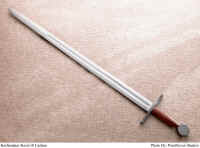 3. Do you have a particular favorite piece you most enjoy constructing
or working on? 3. Do you have a particular favorite piece you most enjoy constructing
or working on?
"Anything new and interesting, I am a horrible businessman since
anytime one item gets popular and I start to see too much demand for it
I have a tendency to steer away from it before I go out of my mind from
boredom. I went through a Saxon and Viking style phase that I am now on
the tail end of with my appetite fairly satisfied, and now I have a hunger
for later renaissance stuff."
4. Can you identify any major breakthrough that transformed your own
study of bladesmithing?
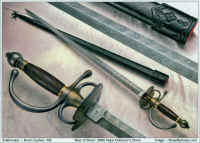 "Study of sound metallurgical principles and what
is actually going on inside of steel, changed bladesmithing for me
forever. It also made me a little lonelier since so many in my field work
off from old folklore and theories that border on superstition. Most smiths
that try to apply sound metallurgy to their craft have an agenda to prove
the eggheads of science wrong so they haphazardly apply the information
and then walk away to tell people that those scientific ideas were made
up for industry and don't apply to blades. "Study of sound metallurgical principles and what
is actually going on inside of steel, changed bladesmithing for me
forever. It also made me a little lonelier since so many in my field work
off from old folklore and theories that border on superstition. Most smiths
that try to apply sound metallurgy to their craft have an agenda to prove
the eggheads of science wrong so they haphazardly apply the information
and then walk away to tell people that those scientific ideas were made
up for industry and don't apply to blades.
I have spent many years now studying how steel really is steel and just
having it in the shape of a blade does not magically create exceptions
to the laws of physics. By applying the principles properly and knowing
how to interpret the results I have found virtually every metallurgical
concept that works for industry will work splendidly for blades, allowing
for improvements simply not possible when adhering to medieval heat treating
practices. I cannot fault my colleagues, who don't always get into the science
as much as I do, however, since I have spent much more money and effort
into collecting the library and testing equipment necessary to really
analyze steel at that level. I often complain that I spend just as much
time looking into my microscopes as I do standing at an anvil, and that
is not good if you wish to make blades for a living."
5. What was one of the hardest skills to learn in historical
bladesmithing?
"Proper heat treating, but it is so hard to learn because misinformation
so often has smiths doing things backwards in order to meet bizarre definitions
of success. It is hard to do things better when the ways that are considered
'the best' are in reality at odds with what you should be doing. But then
I am kind of going against 'traditional bladesmithing' with this, am I
not?
 So if I stuck specifically to traditional smithing, I would say that mastering
heat is the greatest skill. Knowing proper temperatures is very important,
but before one can worry about this they need to take care of the heat
source. Building and maintaining a proper forge fire is a dying art; most
folks I see working with coal today have trouble with the complicated
multi tasking of keeping a fire clean, maintaining a proper air blast
and making fresh coke while keeping the green coal and sulphur away from
the steel. Many smiths today grin proudly at the huge clinkers they are
able to make with no idea of what this tells the public about their skills
as a smith. Of course, charcoal is the original 'traditional' fuel and
it is a good thing that it is regaining popularity with the waning skill
level with coal." So if I stuck specifically to traditional smithing, I would say that mastering
heat is the greatest skill. Knowing proper temperatures is very important,
but before one can worry about this they need to take care of the heat
source. Building and maintaining a proper forge fire is a dying art; most
folks I see working with coal today have trouble with the complicated
multi tasking of keeping a fire clean, maintaining a proper air blast
and making fresh coke while keeping the green coal and sulphur away from
the steel. Many smiths today grin proudly at the huge clinkers they are
able to make with no idea of what this tells the public about their skills
as a smith. Of course, charcoal is the original 'traditional' fuel and
it is a good thing that it is regaining popularity with the waning skill
level with coal."
6. What major tools do you use in your craft?
"Other than the obvious answers of forge, hammer and anvil, I would
say my salt baths for heat treating. They are as far from traditional
blade making one can get, but for having absolute control over the creation
of quality blades they are indispensable. For centuries smiths relied
on judging temperature by color while hoping the lighting conditions were
the same as the last time. With modern equipment one can simply enter
the exact temperature desired for the alloy used and know that the entire
blade will be that temperature throughout. The ability to hold steel at
a precise temperature allows for soak times, a factor critical to tapping
the potential of alloys, not possible with heating methods of the past.
This is not a rejection of the old ways to me since I believe that rather
than spurning such things, as soon as any ancient smith saw the possibilities
of this they would have quickly asked how they could do this as well."
7. Is there a historical piece of work you are most proud of?
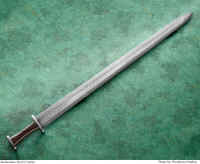 "I don't know about 'proud', I think pride is a thing best kept in
check. I have made some pieces that were hard to part with. That seems
to be a sign of something special in my shop. If I would rather keep it
for myself than sell it, it is probably something special. I have just
finished up a saber that had some very unique historical designs that
were such a challenge that I never wish to do another one like it; if
it were not for the fact that the customer is a real good guy and it is
going to a very good home, I would have a harder time sending it away." "I don't know about 'proud', I think pride is a thing best kept in
check. I have made some pieces that were hard to part with. That seems
to be a sign of something special in my shop. If I would rather keep it
for myself than sell it, it is probably something special. I have just
finished up a saber that had some very unique historical designs that
were such a challenge that I never wish to do another one like it; if
it were not for the fact that the customer is a real good guy and it is
going to a very good home, I would have a harder time sending it away."
8. Is there a major accomplishment in sword making you hope to achieve?
"None in particular, just to continually make a better sword, and
perhaps find the perfect balancing point between historical tradition
and the advantages of modern advances. I have dreams that are probably
just fantasies, as they are like trying to alleviate a tsunami with a
bucket, but I would love to see enough people educated out there to begin
to counteract the garbage that Hollywood and pop culture has fed society.
I know it is just a pipe dream but I also like to imagine a world where
people are aware of hundreds of cultures and blades, a world where the
word sword does not automatically equal katana in the mind of every 17
year old, or 40 year old with equivalent mentality."
9. How active have you ever been in studying or practicing the use
of different swords?
 "Not as active as I would like. I already have cut my productivity
in half by getting wrapped up in what is going on inside of the blade,
I just don't have anymore time to spare right now for getting obsessive
with learning fighting styles and techniques. I spend a lot of time cutting
and just putting the swords into motion. Every one I have made has spent
a good amount of time in motion in my back yard. I think any opportunity
I can get to work with true knowledgeable users is more valuable than
trying to fumble my way through learning those intricacies when I should
be in the shop. But knowledgeable users are very rare, for the obvious
reasons of when we live and for the others of what bad information has
done for us, my filters are getting better at spotting the play actors
from those serious about the study however, and I enjoy my interaction
with the latter." "Not as active as I would like. I already have cut my productivity
in half by getting wrapped up in what is going on inside of the blade,
I just don't have anymore time to spare right now for getting obsessive
with learning fighting styles and techniques. I spend a lot of time cutting
and just putting the swords into motion. Every one I have made has spent
a good amount of time in motion in my back yard. I think any opportunity
I can get to work with true knowledgeable users is more valuable than
trying to fumble my way through learning those intricacies when I should
be in the shop. But knowledgeable users are very rare, for the obvious
reasons of when we live and for the others of what bad information has
done for us, my filters are getting better at spotting the play actors
from those serious about the study however, and I enjoy my interaction
with the latter."
10. How would you say today's sword making community compares
to that of, say, 10 or 15 years ago?
"I think there are a whole lot more actual swords being made these
days than in the past. I remember a time when every piece I saw, from
production down to the best custom one, were actually just sword shaped
objects. I believe this is a result of the 'radical' concept of actually
handling and measuring real original swords. I think we got all those
sword shaped objects in
the past because photos can only give us two dimensions, and a proper
sword is one of the most three dimensional things I have ever handled.
The production stuff suffered the most because without that third dimension,
it just made economical sense to stamp the blade out of flat sheet and
then throw some edges on it."
11. Where do you imagine the reproduction sword industry will be in
10 years or so? What developments do you anticipate, or would you like to see?
 "I am sorry to say that for the majority of the field I don't hold
out much hope of great change, unless we can break from the fad driven
adherence to pop culture. Makers could help if they could stop prostituting
themselves by shamelessly promoting their swords in ways that cater to
the prevailing idiocy. But it is very difficult to ask people to do something
that counters some of the most effective marketing, and thus the maximum
accumulation of the almighty dollar. There is good money in taking advantage
of public misconceptions and naivety; let's face it, hype sells. "I am sorry to say that for the majority of the field I don't hold
out much hope of great change, unless we can break from the fad driven
adherence to pop culture. Makers could help if they could stop prostituting
themselves by shamelessly promoting their swords in ways that cater to
the prevailing idiocy. But it is very difficult to ask people to do something
that counters some of the most effective marketing, and thus the maximum
accumulation of the almighty dollar. There is good money in taking advantage
of public misconceptions and naivety; let's face it, hype sells.
I think we can expect to see more traditional swords, not just in execution
but in materials as well. More and more folks are making their own steel
these days. Changes in the steel industry are not just making raw materials
more expensive but harder to find. Industry is phasing out many of the
very simple steels that were excellent and cleaner approximates to the
original ancient materials. If we have to pay more or not even be able
to find simpler steels to forge, it would just make sense to set up a
small smelting furnace in the back yard and make the actual original product,
not just a modern approximation. This, of course will lead to a resurgence
of other traditional techniques in order to work those materials; my salt
baths will not be as efficient on such inconsistent steels. This may lead
to a divergence of swords on the market, one genre catering to pure performance
from modern advances with little consideration for tradition, the other
sticking with strict authenticity and embracing the learning experience
of the characteristics of the ancient technology and materials."
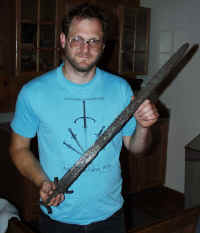 12. How many expert swordsmiths of top notch accuracy would you say
there are in North America at present? 12. How many expert swordsmiths of top notch accuracy would you say
there are in North America at present?
"Due to its framework this is a tough question, I am not sure I could
include myself in that category. Accuracy is a touchy thing, one can make
their own steel and use nothing but hand tools but will it ever be close
enough to an original? To many of what I call 'ancestor worshipers' I
may be blaspheming when I say that I believe that 1000 years of metallurgical
progress may offer distinct advantages over the traditional ways, and
I sometimes encounter features in ancient swords that were results of
limitations of the period that I wouldn't want to reproduce. Once again
this splits the field into two camps, there are some folks making swords
that are pretty good in the performance aspects, but they need to abandon
some tradition to do that, while on the other side there are some guys
who are making blades that would be indistinguishable from neighbors if
put in a display in the Wallace collection, but I don't see as many people
using them to chop things in the back yard. Top accuracy in European stuff
is much rarer here in the U.S. than it appears to be in Europe, but then
look at the difference in access to originals for reference. The folks
who seem to excel in this area are the ones willing to travel to where
the real stuff can be handled."
13. How long have you been involved in living-history reenactment and
how has this influenced or affected your swordmaking?
"Perhaps close to 17 years including my time with Medieval and Renaissance
reenacting, but I grew quite disenchanted with the local groups, which
appeared to be more interested in fantasy role playing and being an outlet
for young people to express new age religions than actually studying Mediaeval
history. When I started designing historically accurate armor, in order
to get a better understanding of combat in that period, I was told it
was all wrong, not because of inaccuracies, but because the glancing surfaces
were all wrong for rattan swords and the people with lighter PVC armor
would beat me every time. This definitely started my wondering if I was
pursuing my interests with the right group. I did hang around longer and
try to educate as much as I could about blade making, but more than once
I would show somebody a multi bar pattern welded blade only to be told,
'Yep I know my, neighbor makes blades just like that out of truck springs,
you should try truck springs!' Around the third time I heard 'We recreate
the middle ages the way they should have been' I was definitely ready
to move on.
About that time I was doing a demonstration at a local event when I was
approached by a big bearded long haired man, who is now a very good friend,
asking if I would consider participating in a local rendezvous. I didn't
see much sword play involved in the Rocky Mountain fur trade, but I love
camping and general smithing would fit right in. I think it may be because
we can identify easier with that period, but I was delighted to find widespread
attempts at historical accuracy, and portrayals of history as it actually
was, the good the bad and the ugly. The time frame was more diverse than
expected as well, also covering the later half of the 18th century. It
got me making a few small swords and trained my masculine side to be more
comfortable with something like powdered wigs, it is easier to wear white
wigs and stockings when you have a sword on your side and an attitude
in your eyes. But the most it gave to me is time away from the forge with
my family. It is liberating to sit and listen to folks talk about knives
and swords while having no idea who the fop on the other side of the fire
is."
14. What would you say are some of the more challenging aspects of
making historically accurate swords today?
"One of the top issues is getting the handling right. In the past
there was a great pool of knowledge for weapon makers to draw from, that
was the number of people actually putting their life on the line in battle
with swords. I may ruffle feathers by revealing why I have a silly smirk
on my face whenever I hear the word 'tactical' applied to modern blades,
but the fact is I am fighting the urge to laugh. It just seems silly to
have somebody in the 21st century claiming to be developing great designs
in tactical edged weaponry, it is like somebody proclaiming they have
the ultimate mammoth hunting device; without producing evidence of any
number of confirmed mammoth kills I will need to file that one under 'marketing
hype'.
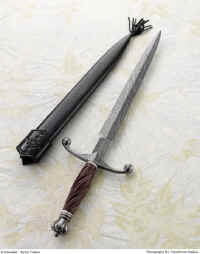 Another interesting thing about the modern evolution of combat blades
is how they don't seem to resemble any of the proven blades of the past,
but instead have very odd features added just to make them look different
from anything before them. To me a tactical blade is a gladius, a dirk,
a main gauche, or a seax! Now those are tactical blades, there was nothing
on them, for the goal of catching eyes in magazines, everything had a
very practical purpose. I am pleased whenever I get to work with a group
like ARMA because it is the only opportunity to approximate that pool
of information that ancients smiths had. Sometimes I fear the predominance
of sword shaped objects on the market has lent momentum to the legitimizing
of the notions of them being correct due to the number of folks working
with them under the assumption that they are correct and developing whole
new manners of using them that compensate or work around their shortcomings. Another interesting thing about the modern evolution of combat blades
is how they don't seem to resemble any of the proven blades of the past,
but instead have very odd features added just to make them look different
from anything before them. To me a tactical blade is a gladius, a dirk,
a main gauche, or a seax! Now those are tactical blades, there was nothing
on them, for the goal of catching eyes in magazines, everything had a
very practical purpose. I am pleased whenever I get to work with a group
like ARMA because it is the only opportunity to approximate that pool
of information that ancients smiths had. Sometimes I fear the predominance
of sword shaped objects on the market has lent momentum to the legitimizing
of the notions of them being correct due to the number of folks working
with them under the assumption that they are correct and developing whole
new manners of using them that compensate or work around their shortcomings.
The other great personal challenge I have found is balancing the fit and
finish, or methods of manufacture from modern handmade knives to historically
accurate swords. The ancients had a whole different idea of how things
should be put together and fit than the modern knife collector. Sometimes
as much as 40-50% of my business is custom knives and if I fit a blade
and hilt together for them in the way that could be considered almost
'perfect' to the historical sword enthusiast, not only couldn't I sell
the knife, it could irreparably damage my standing among the discriminating
custom knife collectors. I am in no way saying one is better than the other but they are incredibly different and this puts me in a very tough
spot, because on the other side of the coin if I go with the seamless
machine like precision that is demanded on the custom knives with one
of my swords, the historical accuracy purists will be quick to say that
Cashen doesn't make 'proper' swords. I believe I am coming to grips with
it now since I have established myself with the public, but the newer
smiths will have a really hard time with this one and will have to keep
the two worlds entirely separate for a while."
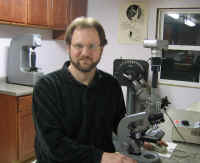 15. What can you tell us about your metallurgical analysis work and the challenge it posed to the status quo of some circles of bladesmithing? 15. What can you tell us about your metallurgical analysis work and the challenge it posed to the status quo of some circles of bladesmithing?
"After being steered in an odd direction by so much of the misleading or erroneous information that too many of my contemporaries work under, I began to ask questions. You know, the kind of questions that could have got you tied to a post atop a pile of very dry kindling about 600 years ago, or got that troublemaker Galileo tossed behind bars for the rest of his days. How little has changed over the centuries, since my skepticism was met with much resistance and even outright hostility from the followers of the established wisdom. People want to believe in ancient secrets that make magic blades and when you threaten these fantasies, they don't like it. Along with this are a number of charismatic makers who got way too much ink so that they could sell their stuff for irrational prices and thus create a fanatical following of people needing to justify why they paid such a price. It all created a very strong status quo that relied on hype to maintain order."
"While asking my dangerous questions, I found that offering the laws of physics, and the science that works everywhere else in the world, was not [rebuttle] enough, since the fanatical followers of any of these irrational schools of thought would simply find reasons as to why the same principles didn't apply to blades and that when it came down to my word against their guru's, my less exciting explanation would lose out. I had to admit that on the latter, they had a point: everything did seem to be based on somebody's opinion or word. So, I came up with a plan to allow the steel to speak for itself."
"Even if a bladesmith got access to a professional metallurgy lab it can be so far removed from blades that the folks there would have a hard time looking for things pertinent to blade making. So, some years ago I began assembling equipment to investigate the behavior of blades and my treatments of them in my own shop. Then I finally broke ground on a clean room that I refer to as my metallurgy lab, which would be less of another part of my manufacturing but more a 'CSI' type lab for fact finding in bladesmithing. I filled it with the typical things like hardness testers, but also with more involved gadgets like a Charpy impact tester (too many test sword steel by flexing it, but swords are made to impact things not slowly flex on them), and, most valuable to me, a collection of metallurgical microscopes that allow me to stop guessing or taking some bozo's word for it, but actually see what is happening inside the steel---that is, how the various heat
treatments effect affect the alloys metallurgically."
"This capacity has completely changed my entire approach and outlook to bladesmithing, and has completely exposed the myth and hype that has been foisted on the public for too long. The ability to do objective quantifiable analysis of the material properties has freed me from the shackles of the custom-tailored and subjective tests that virtually every other bladesmith relies upon to make their methods or products look better. Although I am not in business as a lab for hire, I have done some professional analysis for other makers who were confident enough not to need the dog and pony shows and want honest feedback about their blade-making process."
16. Do you have any coming plans you can share about future sword projects?
"I can give you a hint, look where nobody else is looking. I have never been able to stomach fads or trends; if too many people start doing what I am doing I will quickly move on. Being a wall flower or just another face in a crowd would be worse than death to me. Many years ago when I saw that everybody with some steel and the ability to make fire would eventually start making katanas, I knew I would not be making many of them in my career. I caught the Migration period and Viking style pattern welding fever a few years back without realizing how contagious it would be. Now there are enough other people doing it, in ways rather familiar, that my enthusiasm is fading a bit. This character flaw is very bad for my income, when every time something really catches on I abandon it."
June 2007 |

